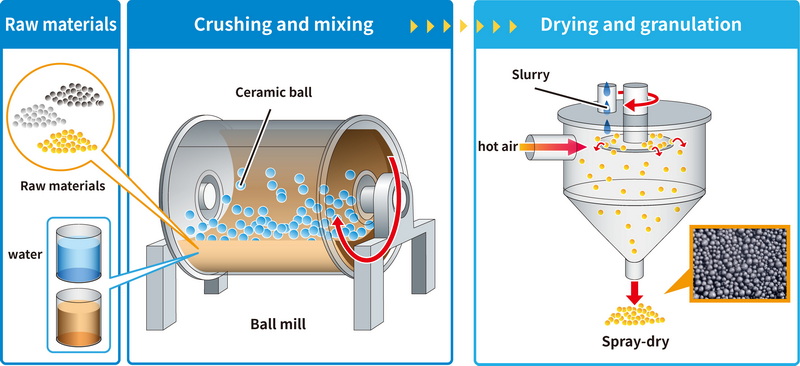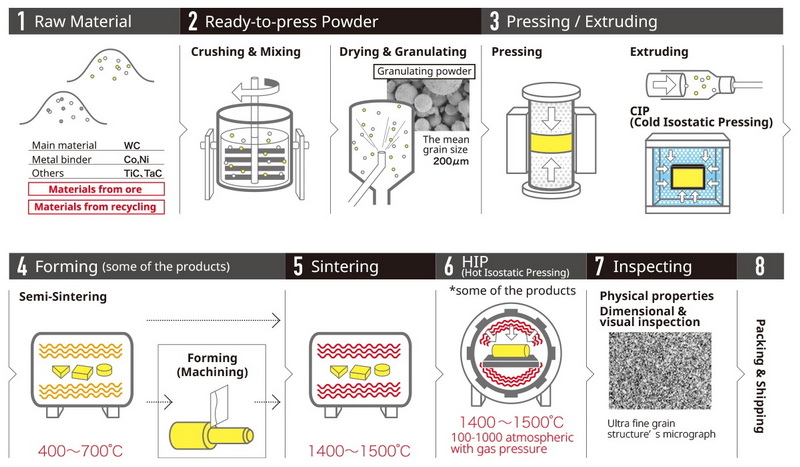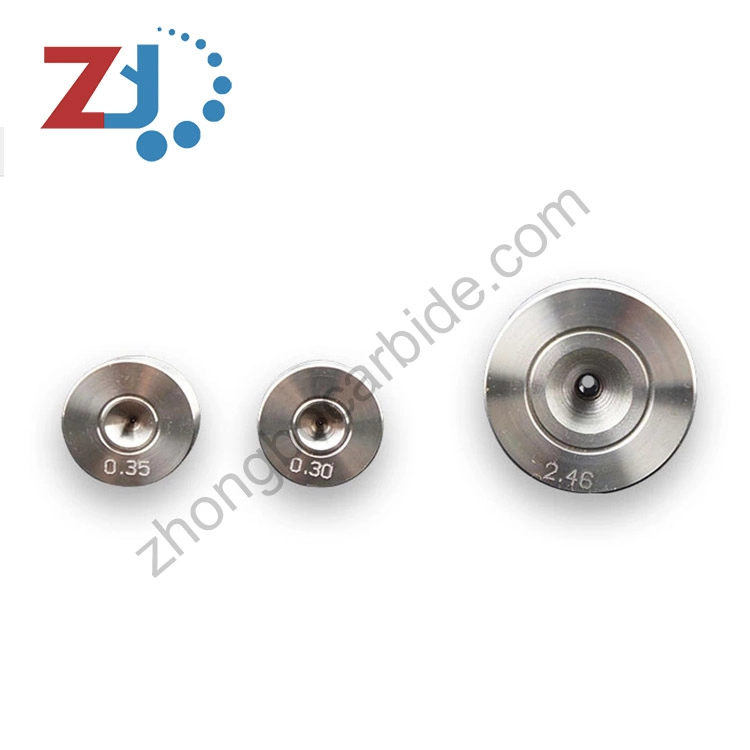Content Menu
● Introduction to Tungsten Carbide Inserts
● Manufacturing Process of Tungsten Carbide Inserts
>> 1. Powder Preparation
>> 2. Mixing and Milling
>> 3. Shaping
>> 4. Sintering
>> 5. Hot Isostatic Pressing (HIP) (Optional)
>> 6. Finishing
● Applications of Tungsten Carbide Inserts
● Benefits of Tungsten Carbide Inserts
● Challenges and Future Developments
● Recycling of Tungsten Carbide Inserts
● Quality Control and Testing
● Conclusion
● FAQs
>> 1. What are Tungsten Carbide Inserts Made Of?
>> 2. How Long Do Tungsten Carbide Inserts Last?
>> 3. Can Tungsten Carbide Inserts Be Used for All Materials?
>> 4. What is the Difference Between Turning and Milling Inserts?
>> 5. Are Tungsten Carbide Inserts Cost-Effective?
● Citations:
Tungsten carbide inserts are highly valued in various industries for their exceptional hardness and durability, making them ideal for cutting tools used in metalworking, mining, and construction. The manufacturing process of these inserts involves several complex steps, from powder preparation to final sintering. This article will delve into the detailed process of how tungsten carbide inserts are made, highlighting their applications and benefits.

Introduction to Tungsten Carbide Inserts
Tungsten carbide inserts are composed primarily of tungsten carbide and cobalt. The tungsten carbide provides hardness, while the cobalt acts as a binder, enhancing the insert's toughness and resistance to wear. These inserts are widely used in cutting tools such as drills, end mills, and turning tools, benefiting from their ability to cut through tough materials efficiently.
Manufacturing Process of Tungsten Carbide Inserts
The manufacturing process involves several key steps:
1. Powder Preparation
The journey begins with the selection and preparation of high-purity tungsten carbide and cobalt powders. The quality of these raw materials is crucial for the final performance of the insert.
- Raw Material Selection: Tungsten carbide and cobalt powders are sourced. The cobalt content typically ranges from 6% to 30%, depending on the intended application.
- Powder Analysis: The powders are analyzed for particle size distribution, purity, and chemical composition.
- Weighing and Proportioning: Precise amounts of tungsten carbide and cobalt powders are weighed according to the desired grade specifications.
- Additive Incorporation: Additional carbides like titanium carbide or tantalum carbide may be added to enhance specific properties such as thermal shock resistance or hardness.
2. Mixing and Milling
This step ensures the homogeneity of the final product.
- Initial Mixing: The measured powders are mixed in a V-blender or turbula mixer.
- Ball Milling: The mixture is transferred to a ball mill for further mixing and grinding.
- Wet Milling: A liquid medium, typically alcohol, is added to facilitate milling and prevent oxidation.
- Milling Duration: The process can last from 24 to 72 hours, depending on the desired particle size.
- Particle Size Reduction: Particles are reduced to submicron sizes, typically ranging from 0.5 to 5 micrometers.
- Drying: The slurry is dried using spray drying or vacuum drying techniques.
3. Shaping
The dried powder is then pressed into the desired shape using a die. This can be done through various methods, including uniaxial pressing or isostatic pressing.
- Uniaxial Pressing: This method involves applying pressure in one direction to form the insert.
- Isostatic Pressing: Pressure is applied from all sides to ensure uniform density.
4. Sintering
Sintering transforms the fragile green compact into a dense, hard carbide insert.
- Furnace Loading: The green compacts are loaded into a sintering furnace.
- Atmosphere Control: The furnace atmosphere is controlled to prevent oxidation.
- Temperature Ramp-Up: The temperature is increased to around 1400°C.
- Holding Period: The temperature is maintained for a specific period, allowing the cobalt to melt and bind the carbide particles.
- Cooling: The furnace is slowly cooled, allowing the cobalt to solidify and bind the carbide particles together.
5. Hot Isostatic Pressing (HIP) (Optional)
Some inserts undergo HIP to eliminate any remaining porosity, resulting in a fully dense structure.
- High-Pressure Environment: Inserts are placed in a chamber filled with inert gas at high pressure.
- Elevated Temperature: The chamber is heated to temperatures close to the sintering temperature.
- Pore Elimination: The combination of high pressure and temperature eliminates porosity.
6. Finishing
The final step involves grinding and polishing the inserts to achieve the desired shape and surface finish.
- Grinding: The inserts are ground to precise dimensions using diamond-coated grinding wheels.
- Polishing: A final polishing step ensures a smooth surface, reducing friction during machining.

Applications of Tungsten Carbide Inserts
Tungsten carbide inserts are used in various industries due to their exceptional hardness and durability:
- Metal Cutting: Ideal for machining metals like steel, aluminum, and cast iron.
- Mining: Used in drill bits for rock drilling.
- Construction: Employed in tools for construction and heavy machinery.
- Aerospace: Essential for precision machining of components.
Benefits of Tungsten Carbide Inserts
The benefits include:
- Longer Tool Life: Reduces downtime and tool changes.
- Enhanced Efficiency: Cuts through tough materials with ease.
- Sustainability: Reduces waste and resource consumption due to extended lifespan.
Challenges and Future Developments
Despite their advantages, tungsten carbide inserts face challenges such as high production costs and environmental concerns related to tungsten mining. Future developments focus on improving manufacturing efficiency, exploring alternative materials, and enhancing recyclability.
Recycling of Tungsten Carbide Inserts
Recycling is becoming increasingly important to reduce waste and conserve resources. Used inserts can be collected and processed to recover tungsten carbide, which can then be reused in new products.
Quality Control and Testing
To ensure the quality of tungsten carbide inserts, manufacturers conduct rigorous testing, including hardness tests, impact tests, and microstructural analysis. These tests verify that the inserts meet the required standards for performance and durability.
Conclusion
Tungsten carbide inserts are crucial components in cutting tools, offering exceptional hardness and durability. Their manufacturing process involves precise steps from powder preparation to sintering, ensuring high-quality products. These inserts are widely used across industries, contributing to efficiency and sustainability. As technology advances, improvements in manufacturing processes and recycling methods will further enhance their value.

FAQs
1. What are Tungsten Carbide Inserts Made Of?
Tungsten carbide inserts are primarily made from tungsten carbide and cobalt. The tungsten carbide provides hardness, while the cobalt acts as a binder, enhancing toughness and wear resistance.
2. How Long Do Tungsten Carbide Inserts Last?
The lifespan of tungsten carbide inserts depends on factors like machining conditions and material being cut. Generally, they last significantly longer than traditional cutting tools.
3. Can Tungsten Carbide Inserts Be Used for All Materials?
While versatile, tungsten carbide inserts are particularly effective on metals like steel, cast iron, and aluminum. Their effectiveness may vary based on material properties.
4. What is the Difference Between Turning and Milling Inserts?
Turning inserts are designed for shaping and finishing operations on CNC lathes, while milling inserts are used for removing material from surfaces during milling operations.
5. Are Tungsten Carbide Inserts Cost-Effective?
Yes, although they may have a higher initial cost, their durability and performance lead to lower overall costs due to reduced downtime and tool changes.
Citations:
[1] https://onmytoolings.com/how-are-carbide-inserts-made/
[2] https://www.alamy.com/stock-photo/carbide-insert.html
[3] https://www.zgcccarbide.com/news/exploring-the-benefits-and-applications-of-of-tungsten-carbide-inserts-in-metallurgy-172.html
[4] https://blog.csdn.net/qq_34917728/article/details/125122327
[5] https://www.zgcccarbide.com/news/The-Manufacturing-Process-of-Cemented-Carbide-Inserts:-A-Comprehensive-Guide-39.html
[6] https://www.istockphoto.com/photos/tungsten-carbide
[7] https://www.sourcifychina.com/tungsten-carbide-insert-guide-in-depth/
[8] https://pmc.ncbi.nlm.nih.gov/articles/PMC10930229/
[9] https://www.hjcarbide.com/new/How-Tungsten-Carbide-Inserts-are-made.html
















